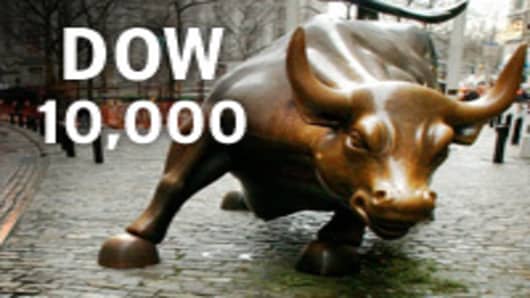It took the Dow over a year to get back to 10,000, but the rally that got it there may still not be over.
But while stocks may continue to rise, pros suggest that investors start looking for ways to protect their gains if the rally runs out of steam.
Market experts both on trading floors and at portfolio managers gave measured levels of importance to the latest market milestone. At the same time, they say investors shouldn't try to stand in the way of the Wall Street stampede.
"Big, round numbers on indexes or commodities are in fact important and trigger buys as resistance is overcome," says Jordan Kimmel, market strategist at National Securities in New York. "While this is not the first time we've seen Dow 10,000, it's still a very important hurdle to get past, to get through and to leave behind."
The first move past 10,000 on Wednesday literally lasted seconds, but the Dow later closed firmly above that mark.It was the first time in a year that the 30-stock bluechip index passed five figures and marked a return to where it was 10 years ago.
After such a volatile decade, the rugged resistance to 10,000 and the minor pullback afterwards did not go unnoticed on Wall Street. The move, in fact, fed into a mindset that while increasing numbers of investors are moving to net-long positions on the market, they're also getting more aggressive in trying to find protection should the rally begin to falter.
"The way that the bond market is acting right now, we're seeing a lot of money in the last couple of sessions coming out of Treasurys," says Dave Lutz, managing director of trading for Stifel Nicolaus in Baltimore. "If this trend continues we might fuel this right to the moon."
Lutz had felt recently that passing 10,000 might represent a sell opportunity. Now, he's placing more emphasis on finding ways to hedge against long positions if stocks fall from their lofty perch compared to the March lows.
"We're seeing volume very light," he says. "It seems like the market has gotten a little complacent and a little dull. One of the biggest Wall Street adages is you never sell a dull market. As we go over 10,000 I'm going to consider buying protection against positions that we have already on the books."
One of the more common ways for investors to shield against downside is through the Chicago Board Options Exchange Volatility Index .
Often referred to as Wall Street's "fear gauge," the VIX reflects options activity on the Standard & Poor's 500 and generally falls as stocks go higher. The VIX value reflects how much it costs investors to buy protection; the measure peaked near 90 during the worst of the financial crisis, but a reading in excess of 30 generally reflects high volatility.
That relationship, though, could change, if the VIX buck historical trends and moves in unison as investors get increasingly suspicious about whether the rally can be sustained.
"It makes absolutely all the sense in the world to protect your portfolio at the moment," Paul Britton, CEO and founder of Capstone, said in an interview with CNBC. "No one buys this rally—it's based purely upon technicals, people are underweight equities and you should use volatility and the options instruments to lock in some of the gains that the bulk of the investors have made this year."
Investors are employing a variety of other strategies to combat moves lower.
The choices range from put options that would profit investors by selling if a stock hits targeted lower levels, while others are using covered calls and aggressive stop-loss placements that also limit the moves lower.
But there's also a bullish rage running through the market that has others, such as famed investor Jim Rogers, unwilling to step in front of the Wall Street runaway train.
Rogers said in a recent interview with Reuters that the market is "overdue for a correction" but he was not willing to short either stocks or commodities at this point. Rather, he said that Treasurys are a bubble likely to burst.
The view is shared by those who think that 10,000, rather than being a resistance or resting point for the market, actually could trigger another rally.
"I would anticipate maybe some backing and filling over the next couple of weeks after 10,000 is cleared," Kimmel says. "But I certainly expect 10,000 to become a distant signpost as we go significantly higher."



